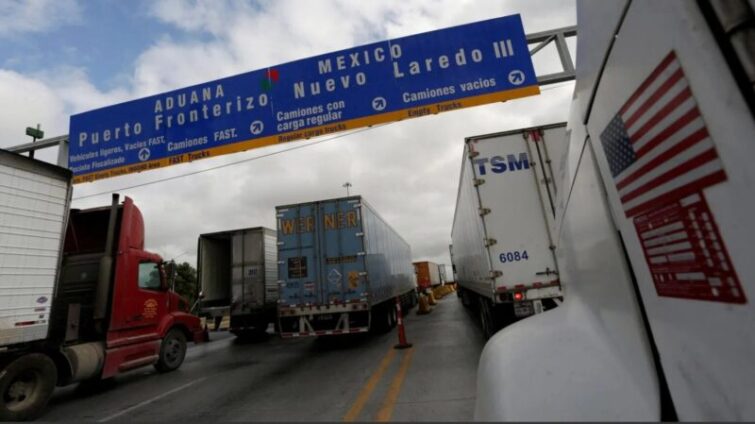Trump vows tariffs on Mexico, Canada and China on day one
4 min read
Donald Trump has vowed to impose new tariffs on China, Mexico, and Canada on his first day as president if he is re-elected in 2024. He aims to use these tariffs as a tool to force these countries to take stronger action against illegal immigration and drug trafficking into the United States.
In a statement, Trump announced that he would sign an executive order imposing a 25% tariff on all goods imported from Mexico and Canada starting on January 20, 2025. Additionally, he said he would impose a 10% tariff on Chinese imports until the country takes more effective steps to stop the flow of fentanyl, a deadly opioid, into the U.S.
This move threatens to escalate tensions with the U.S.’s three largest trading partners. It could result in higher prices for American consumers, as tariffs are essentially a tax on imports. The U.S. is the world’s largest importer, and China, Mexico, and Canada account for roughly 40% of the country’s $3.2 trillion worth of annual imports.
China has defended its efforts to curb illegal drug shipments and warned that a trade war would have no winners. After Trump’s tariff announcement, he reportedly discussed trade and border security with Canada’s Prime Minister Justin Trudeau, who characterized the conversation as “good.” Meanwhile, Mexico’s finance ministry emphasized that the United States-Mexico-Canada Agreement (USMCA), which governs trade relations between the three countries, provides a stable framework for investment.
Trump’s tariffs on Mexico and Canada would remain in effect until both countries address the issues of drug smuggling and illegal immigration. In a post on his Truth Social platform, Trump claimed that both nations have the power to easily resolve these issues, calling for them to “pay a very big price” for not doing so. In a subsequent post, he also criticized China for not following through on promises to enforce the death penalty for those caught dealing fentanyl.
The Chinese government responded by rejecting Trump’s claims, saying that the idea of China knowingly allowing fentanyl precursors to enter the U.S. is inaccurate. A spokesperson for the Chinese embassy in Washington stated that China-U.S. economic cooperation is mutually beneficial and warned that no one wins in a trade war.
The Biden administration has repeatedly urged China to take stronger action to curb the production and distribution of fentanyl and its precursors. The opioid crisis in the U.S. has been devastating, with fentanyl responsible for nearly 75,000 American deaths last year alone.
During his 2020 campaign, Trump warned of even higher tariffs on Mexico and China, including the possibility of up to 100% tariffs if needed. He also indicated plans to end China’s most-favored-nation trade status, which grants China preferential treatment in U.S. trade agreements.
In 2023, over 80% of Mexico’s exports and about 75% of Canada’s exports were sent to the U.S. Even with ongoing trade tensions, the U.S. remains a critical market for China, accounting for about 15% of Chinese exports.
A tariff is essentially a tax levied on imported goods, which is paid by the domestic company that imports them. For example, a car worth $50,000 would be subject to a $12,500 tariff if a 25% tax is imposed. Trump has championed tariffs as a way to protect American jobs and grow the U.S. economy. While he claims that these taxes do not burden American consumers, economists argue that the ultimate cost of tariffs is passed on to U.S. buyers, who face higher prices for imported goods.
Trump’s economic approach during his first term included implementing numerous tariffs, many of which have remained in place under President Biden. Economic studies suggest that the burden of these tariffs has largely fallen on U.S. consumers, not foreign producers. It remains unclear whether the proposed 10% tariff on China would be in addition to the 25% tariffs planned for Mexico and Canada, or if it would apply to specific goods.
Trump’s tariff strategy reflects his broader approach to trade negotiations, which often involves escalating tensions before seeking a resolution. His former Treasury Secretary pick, Scott Bessent, described this as a “escalate to de-escalate” approach, where Trump uses threats of tariffs to extract concessions.
The potential tariffs on Mexico and Canada appear to breach the terms of the USMCA, the trade agreement that Trump negotiated and signed into law in 2020. The agreement allows for largely duty-free trade between the U.S., Mexico, and Canada. However, Trump’s proposed tariffs could disrupt this arrangement, sparking significant backlash.
In response, Canadian and Mexican leaders have criticized the tariff plan. Doug Ford, Premier of Ontario, warned that such tariffs would harm workers and jobs on both sides of the border. Gerardo Fernández, the leader of the Mexican Senate, questioned what tariffs the U.S. should face until it stops consuming drugs and exporting weapons illegally.
Trump’s proposed tariffs are seen as part of a broader strategy to reshape U.S. trade relationships, using economic pressure to achieve policy goals. However, they also carry the risk of intensifying trade conflicts and harming industries that rely on cross-border trade.







